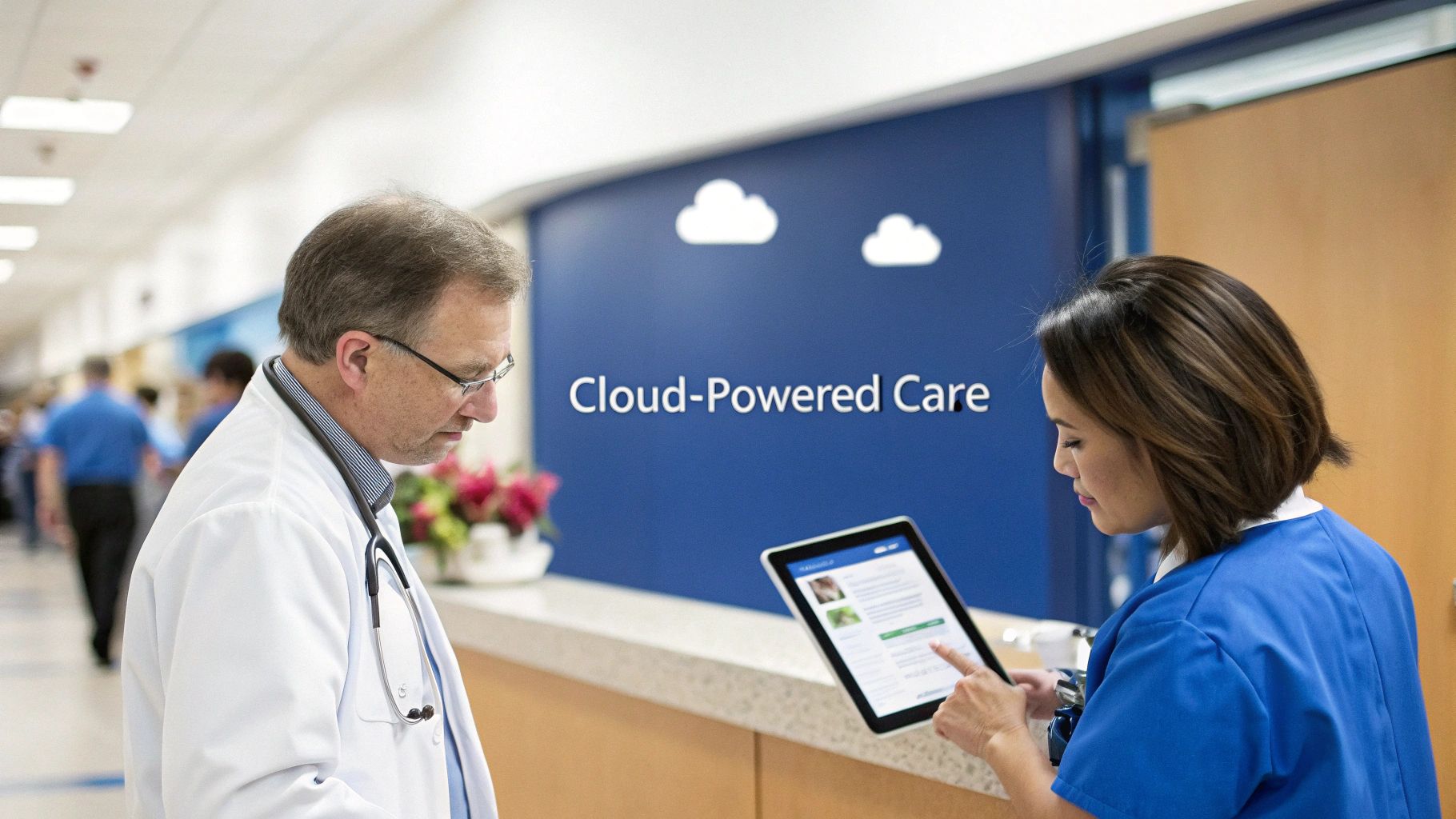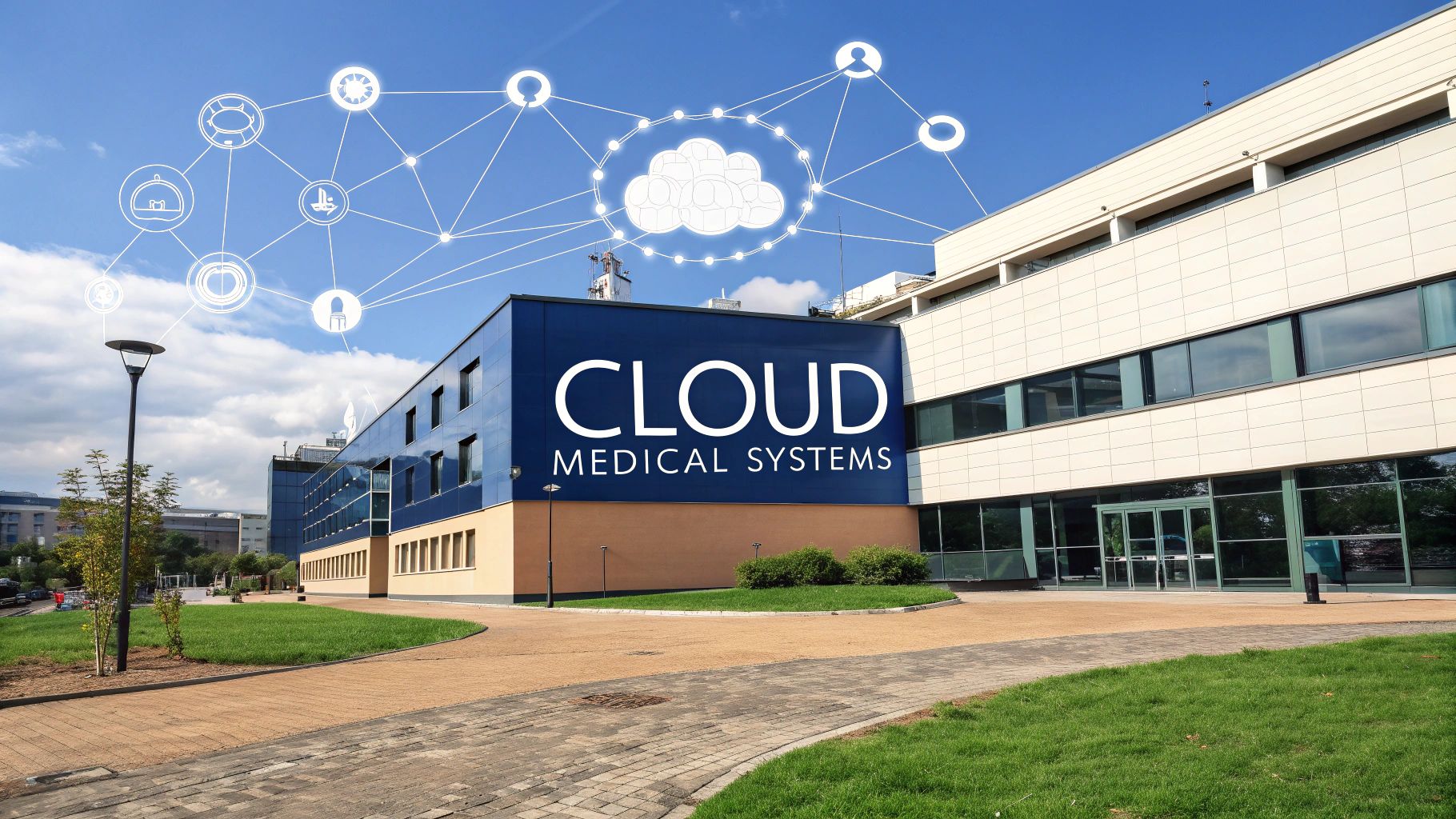At its core, a cloud-based medical system is about shifting healthcare data and software from a server down the hall to a secure, professionally managed data centre. Think of it like moving your money from a home safe to a modern, insured digital bank. It's not just about storage; it’s about making that data more accessible, secure, and useful for delivering better patient care.
Why the Future of Healthcare Is in the Cloud
Remember the leap from paper files to digital records? We're in the middle of another one just as significant, moving from isolated, on-site servers to interconnected cloud platforms. This isn’t just some IT trend; it’s a direct response to the tidal wave of health data we're now creating.
Information from wearables, telehealth sessions, and sophisticated diagnostic tools is simply too much for traditional IT setups to handle. On-premise servers are costly to maintain, a nightmare to scale up, and they often create data silos that prevent different departments, or even different clinics, from seeing the complete patient picture.

The Urgent Need for a Modern Approach
The old way of doing things is a roadblock to both patient care and operational agility. A hospital might find it painfully slow to get a new telehealth service running or struggle to integrate vital data from a partner lab. Cloud-based medical systems are built to solve exactly these kinds of problems, offering a flexible and powerful backbone for modern healthcare.
This push is coming from a few key places:
-
Data Growth: The sheer amount of patient data being generated every day demands storage and processing power that most on-premise solutions just can't deliver without massive, ongoing investment.
-
Patient Expectations: People are used to on-demand services in every other part of their lives. They now expect the same from their healthcare – easy access to their records, virtual appointments, and personalized communication.
-
Operational Demands: Providers need systems that let care teams collaborate effortlessly, automate tedious administrative work, and deliver real-time insights that can actually improve outcomes.
Unlocking New Possibilities in Patient Care
Switching to cloud-based medical systems is about much more than just online storage. It's about building a connected healthcare ecosystem where critical information flows securely to wherever it’s needed most.
Imagine a specialist reviewing a patient's MRI scans from their home office, or a family doctor getting a real-time alert from a patient's continuous glucose monitor. This kind of seamless, instant access simply wasn't possible with older, siloed systems.
The real game-changer is turning all those disconnected bits of data into something truly useful, actionable clinical insights. By bringing information together, organisations can use advanced analytics and even AI to spot trends, predict health risks, and create truly personalised treatment plans.
Getting this transition right requires a clear strategy. Our experience in delivering end-to-end cloud solutions is focused on helping healthcare organisations build that secure and scalable foundation. We build comprehensive cloud solutions that free up providers to concentrate on what they do best: looking after their patients.
The Building Blocks: Understanding Cloud Models in Healthcare
When we talk about "the cloud" in healthcare, it's not a one-size-fits-all solution. Think of it like getting a pizza. You can buy all the raw ingredients and make it from scratch, get a pre-made kit where you just add the toppings, or simply order a finished pizza delivered to your door. Each option gets you a pizza, but the level of effort, control, and expertise required is completely different.
The same idea applies to cloud services. The three main models – Infrastructure as a Service (IaaS), Platform as a Service (PaaS), and Software as a Service (SaaS), offer different levels of control and convenience. Figuring out which one fits your organisation is the first critical step in building a solid cloud strategy.
IaaS: The Do-It-Yourself Foundation
Infrastructure as a Service (IaaS) is the most hands-on model. It’s like leasing a professional-grade kitchen. The provider gives you the oven, stovetops, and refrigerators – the fundamental infrastructure. But you’re in charge of everything else: making the dough, creating the sauce, and managing the entire cooking process from start to finish.
In the world of healthcare IT, IaaS providers like Amazon Web Services (AWS) or Microsoft Azure supply the raw computing power: servers, storage, and networking. This gives your organisation maximum control to build custom applications, run complex data analytics, or host a unique Electronic Health Record (EHR) environment from the ground up. This model is perfect for large hospital networks or research institutions that have very specific technical needs and the in-house IT team to manage that kind of complexity.
PaaS: The Ready-Made Development Environment
Platform as a Service (PaaS) strikes a balance between control and convenience. This is your take-and-bake pizza kit. The base and sauce are already made for you, so you don't have to worry about the foundational stuff. You get to focus on the creative part – choosing and adding all your favourite toppings before you pop it in the oven.
With PaaS, the provider manages the underlying servers, operating systems, and storage. This creates a ready-made environment where your developers can focus purely on building, testing, and deploying custom software. For instance, a healthcare organisation could use a PaaS model to quickly develop a new telehealth application or a specialised patient portal without getting bogged down in server maintenance. This approach is a core part of our Cloud Enablement Services, designed to help healthcare teams innovate much faster.
SaaS: The All-in-One Solution
Software as a Service (SaaS) is easily the most familiar and user-friendly model. This is the pizza delivered right to your door, hot and ready to eat. You just open the box and enjoy it. The vendor handles everything from cooking and assembly to delivery and cleanup.
In healthcare, many of the tools you use daily are SaaS products – think cloud-based EHRs, practice management software, and medical billing platforms. A small clinic can subscribe to an online EHR and be up and running almost instantly, with no on-site servers or IT staff needed to manage the software. The vendor takes care of all the updates, security patches, and maintenance behind the scenes.
The sheer convenience of this model has made it a dominant force. In Canada, for example, web and cloud-based EHR solutions now account for nearly 87% of the total EHR market revenue, a clear sign that providers prefer its scalability and simplicity.
Choosing the right service model is ultimately a trade-off between control and convenience. IaaS gives you the keys to the entire kingdom, while SaaS provides a turnkey solution that lets you focus completely on patient care. Your organisation's goals, resources, and technical expertise will point you to the right choice.
To really see the differences, it helps to lay them out side-by-side. Our team helps clients navigate these options with our comprehensive cloud solutions, making sure the architecture you choose is a perfect match for your operational needs.
Comparing Cloud Service Models for Healthcare IaaS vs PaaS vs SaaS
The table below breaks down the key differences between the three main cloud service models. It highlights who manages what, offers real-world healthcare examples, and provides a simple analogy to help you find the best fit for your organisation.
| Aspect | IaaS (Infrastructure as a Service) | PaaS (Platform as a Service) | SaaS (Software as a Service) |
|---|---|---|---|
| What You Manage | Applications, Data, Runtime, Middleware, OS | Applications, Data | Nothing, the vendor manages everything |
| Healthcare Use Case | A large hospital building a custom data analytics platform. | A health tech company developing a new patient engagement app. | A private clinic subscribing to a cloud-based EHR system. |
| Analogy | A fully equipped kitchen to cook anything from scratch. | A take-and-bake pizza kit with the base and sauce provided. | A hot pizza delivered directly to your door, ready to eat. |
| Best For | Organisations needing maximum control and customisation. | Developers needing to create and deploy custom applications quickly. | Organisations wanting a ready-made solution with minimal setup. |
Ultimately, whether you need the raw power of IaaS, the creative freedom of PaaS, or the straightforward simplicity of SaaS, the cloud offers a model tailored to every need in the healthcare sector.
The Real-World Benefits of Cloud Medical Systems
Moving to a cloud-based medical system isn't just an IT project; it’s a fundamental shift in how healthcare gets delivered. The impact is felt everywhere, from the way clinicians work and patients interact with their providers to the organisation's financial health and ability to grow. By swapping out rigid, on-site servers for a dynamic cloud environment, healthcare providers can operate in a much smarter, more effective way.
Right away, the biggest change you'll notice is how much easier it is to access data. Clinicians are no longer chained to a specific desktop or the hospital's network. With secure cloud access, a specialist can pull up patient imaging from a satellite clinic, a doctor can review a patient’s complete history during a home visit, and care teams can work together in real-time, no matter where they are. This kind of seamless access means critical information is always there when it's needed, which leads to quicker, better-informed decisions.
Driving Financial and Operational Efficiency
One of the strongest arguments for moving to the cloud is the money you'll save. Traditional, on-premise servers demand a huge upfront investment in hardware, not to mention the ongoing costs of maintenance, power, and physical security. Cloud systems completely flip that model around.
The cloud turns your IT spending from a massive capital expense (CapEx) into a predictable operational expense (OpEx). Instead of buying and maintaining costly hardware, you pay a subscription for what you actually use, just like a utility bill.
This isn't just about saving money; it’s about gaining incredible flexibility. A growing clinic can easily add more storage and computing power to handle new patient data without the headache of buying and installing new servers. This elasticity means your system grows with you, preventing slowdowns and ensuring your IT infrastructure is ready for the future.
This infographic gives you a great visual breakdown of the different cloud service models, from the foundational infrastructure you manage yourself (IaaS) to ready-to-use software (SaaS).

As the diagram shows, each model offers a different trade-off between control and convenience, letting you pick the approach that makes the most sense for your organisation's needs.
Fostering Collaboration and Advanced Analytics
At their core, cloud platforms are built for teamwork. They finally break down the information silos that have held healthcare back for so long, creating a single, secure space where different departments and even separate facilities can share information. This is absolutely essential for coordinated care, especially for patients with complex conditions who see multiple specialists.
On top of that, these systems are the perfect launchpad for next-generation technology. The massive processing power of the cloud makes it possible to run artificial intelligence (AI) and machine learning (ML) models that can predict health issues, flagging at-risk patients before their conditions become serious. Cloud systems also open up new possibilities for staff development, including using top AI tools for enhanced healthcare training.
The growth here speaks for itself. The Canadian cloud computing market, currently valued at USD 14.52 billion, is expected to skyrocket to USD 49.86 billion, largely because of healthcare's digital transformation. This boom shows just how much confidence the sector has in the cloud to deliver better results.
Getting these benefits isn't automatic; it requires a smart strategy. A well-designed cloud solution is about more than just moving data. It’s about rethinking workflows to take full advantage of what this powerful technology can do.
Getting Security, Compliance, and Data-Sharing Right
For a lot of healthcare leaders, the conversation about cloud medical systems almost always hits two big concerns: keeping patient data safe and getting different systems to talk to each other. It’s natural to feel hesitant about cloud security, and the challenge of connecting separate digital health records is something the industry has wrestled with for years. The good news is, modern cloud platforms were built from the ground up to tackle exactly these problems.
There's a persistent myth that on-premise servers are automatically safer. The reality is quite different. Major cloud providers invest in security infrastructure and expertise on a scale most individual healthcare organisations simply can't afford. We're talking about 24/7 monitoring, automated threat detection, and layers upon layers of security that are constantly being updated to stay ahead of new risks.

Upholding Canadian Compliance and Data Sovereignty
Here in Canada, handling patient data means playing by a strict set of rules. The big one is the Personal Information Protection and Electronic Documents Act (PIPEDA), which sets the standard for how private-sector organisations manage personal information. On top of that, provinces like Alberta and British Columbia have their own laws that add even more layers of protection.
A critical piece of this puzzle is data sovereignty. This principle often requires that patient health information stay physically within Canada's borders. Top cloud providers get this, which is why they operate dedicated Canadian data centres. This allows your organisation to keep its data right here at home, meeting all regulatory demands without giving up the power of the cloud.
By choosing a cloud partner with a strong Canadian presence, you can build a system that is not only powerful but also fully compliant with national and provincial privacy laws. This technical foundation is essential for earning and maintaining patient trust.
This shift to digital is already in full swing. Physician offices across the country have hit an incredible milestone, with over 95% adoption of electronic health records (EHR). As the volume of patient data grows and technologies like AI and virtual care become mainstream, the move to cloud-based health IT is only accelerating.
Solving the Interoperability Puzzle
If you've been in health tech for any length of time, you know the biggest headache has always been interoperability, or the lack of it. It’s the reason a patient’s records can be stuck in their family doctor’s EHR, a hospital's system, and a specialist's imaging software, with none of those systems able to speak the same language.
This creates dangerous gaps in information and leads to clunky workarounds like printing and faxing records. It's a problem that modern cloud platforms are perfectly positioned to fix.
By using standardized protocols like Fast Healthcare Interoperability Resources (FHIR), cloud-based systems can finally communicate. Think of FHIR as a universal translator for health data. It lets an app from one vendor securely pull specific patient information from another system, no matter who built it.
This is the key to creating a truly connected care network. When systems can finally talk to each other, incredible things happen:
-
A Unified Patient View: Clinicians get a complete, real-time picture of a patient’s health history, allergies, and medications.
-
Smoother Care Transitions: Information follows the patient automatically as they move between their family doctor, specialists, and the hospital.
-
Empowered Patients: People can access their own complete health records from different providers, all through a single, easy-to-use portal.
Getting this right demands a solid grasp of both the technology and the unique nuances of the Canadian healthcare system. As covered in our guide on healthcare app development in Canada, building in compliance and interoperability from the very beginning is non-negotiable. Partnering with experts who understand these complexities is the surest way to build a system that is both secure and seamlessly connected.
Your Roadmap for Cloud Implementation and Migration
Moving your medical systems to the cloud feels like a massive undertaking. It is. But with a clear, phased roadmap, what seems overwhelming becomes a manageable, strategic project. A carefully planned migration isn't just about avoiding disruptions and keeping data safe; it's about setting your organisation up for success for years to come.
The real work starts long before a single file is moved. It begins with a hard look at your current systems, workflows, and what you're actually trying to achieve. One of the biggest mistakes we see is rushing this initial step, which almost always leads to blown budgets and operational chaos down the road.

Phase 1: Assessment and Strategic Planning
This is where you figure out the 'why' and the 'how'. It's a deep dive into your existing IT infrastructure, pinpointing what’s not working and getting crystal clear on what you hope to gain by moving to the cloud.
During this stage, your team should focus on:
-
Mapping Your Current Systems: Get a complete picture of your applications, where data lives, and how everything connects. You need to know exactly what you're working with before you can move it.
-
Defining Your Objectives: What's the end goal? Are you chasing cost savings, better scalability for growth, more powerful data analytics, or a rock-solid disaster recovery plan?
-
Getting Everyone on Board: Bring your clinical, administrative, and IT leaders to the table. A successful migration depends on making sure everyone's needs are heard and built into the plan from the start.
A solid plan here is your best defence against costly scope creep later. As you chart your course, looking into different cloud-based development services can also give you a major leg up during the implementation.
Phase 2: Secure Data Migration
With your plan in place, the spotlight turns to the most delicate part of the entire process: moving patient data. This phase demands an almost obsessive level of planning to keep security, compliance, and data integrity locked down every step of the way.
A common pitfall is migrating data without cleaning it up first. Simply lifting and shifting messy data just moves your old problems into a shiny new environment.
Data Cleansing is Non-Negotiable. Before you move anything, you absolutely must cleanse, standardise, and de-duplicate your data. Starting fresh in the cloud prevents a world of interoperability headaches and ensures your new system runs on high-quality, trustworthy information from day one.
The migration itself should happen in stages. It's often best to start with less critical data to test your process and iron out any kinks before you touch sensitive patient health information.
Phase 3: Implementation and Testing
Once your data is securely settled in its new home, it's time to build out the system and test it from every conceivable angle. This isn't just a technical check to see if the software works; it's about making sure it works for your people and how they do their jobs.
This phase must include:
-
System Configuration: Customising the cloud platform to fit your clinic's or hospital's unique operational needs and workflows.
-
Integration Testing: Making sure the new cloud system talks flawlessly to your other essential tools, like lab equipment, scheduling platforms, or billing software.
-
User Acceptance Testing (UAT): This is key. Get your clinicians and administrative staff to run through their daily tasks in real-world scenarios. This is how you confirm the system is intuitive and actually makes their jobs easier. For more specifics on this process within a Canadian context, our article on medical software development in Canada offers some valuable insights.
Phase 4: Training and Go-Live
Even the most brilliant technology is useless if your team can't use it. The final, critical hurdle before launch is comprehensive staff training. This training needs to be role-specific, showing each person exactly how the new system helps them with their specific responsibilities.
Then comes the "go-live" day. You can either do a hard cutover or run the old and new systems in parallel for a short time. Whichever route you choose, having robust support from your IT team and cloud partner is absolutely essential to tackle any issues that pop up. This ensures your team feels confident and ready to go from the moment you flip the switch.
Partnering for Your Healthcare Cloud Transformation
For any healthcare organisation looking to stay relevant and competitive, moving to a cloud-based medical system isn't a future project anymore – it's an immediate need. We've walked through how these platforms give you the flexibility, security, and connectivity essential for better patient outcomes and smoother operations. Making this shift is really about delivering the modern standard of care your patients expect.
Pulling this off successfully takes more than just good technology. It demands a partner who truly gets the intricate world of healthcare. The journey involves meticulous planning, bulletproof data migration, and a solid grasp of Canadian compliance rules. One wrong turn can cause major headaches and, even worse, erode patient trust.
Finding the Right Expertise
Choosing the right partner might just be the single most important decision you make in your cloud strategy. A good team doesn't just install software; they help you build a durable, future-ready foundation for all your clinical and business needs. Think of them as your guide, making sure the tech works for your care goals, not the other way around.
This is exactly where our hands-on experience with Cloud Enablement Services makes a real difference. We offer the strategic guidance and technical chops needed to handle every step of your move – from the first look at your current systems to the final launch and beyond. Our whole approach is grounded in a deep understanding of the unique hurdles in the healthcare sector.
A successful cloud transformation is a partnership. It’s about blending your deep clinical knowledge with our technical skill to create a system that truly supports your staff and improves patient care, all while locking down security and compliance.
We’re dedicated to delivering end-to-end cloud solutions that are not only powerful but also practical for your daily grind. As we touched on in our end-to-end cloud solutions guide, a clear, structured plan is what turns a massive project into a manageable success.
The team here at Cleffex has a proven history of helping healthcare organisations navigate this complex process. We genuinely believe the right cloud solutions can change how healthcare is delivered for the better. To see our track record and learn more about our commitment to this work, we encourage you to check out our about us page.
Got Questions About Cloud Medical Systems? We've Got Answers
When healthcare leaders start thinking about moving to the cloud, a few key questions always come up. It's completely understandable – we're talking about critical infrastructure and sensitive data. Let's tackle the big ones: security, cost, and how long it all takes.
Is Patient Data Really Secure in the Cloud?
This is, without a doubt, the number one concern. The short answer? Yes, absolutely. In fact, it's often more secure than what most organisations can achieve on their own.
Think of major cloud providers as digital fortresses. They have entire armies of world-class security experts working 24/7 to protect their infrastructure. They use sophisticated threat detection, automated security protocols, and powerful end-to-end encryption for data, whether it's sitting on a server or moving between systems.
What this means in the real world is that your patient data is protected by a level of security that is constantly evolving to counter the newest threats. For most clinics and hospitals, this far surpasses the security capabilities of a server closet down the hall.
What's the Real Cost of a Cloud EHR System?
This is where the cloud really changes the game financially. Gone are the days of spending a fortune on servers and hardware just to get started. Instead, cloud systems work on a subscription model, which completely flips the script on IT spending.
You move from a massive capital expense (CapEx) to a predictable operational expense (OpEx). It’s a lot like paying for hydro – you only pay for what you use.
-
No More Hardware Headaches: Forget about buying, maintaining, and replacing expensive servers.
-
Budgeting Becomes Simple: A consistent monthly or annual fee makes financial planning much more straightforward.
-
Scale With Your Needs: You can easily add or remove resources as your practice grows or your needs change, so you’re never paying for capacity you don't need.
This model makes modern technology accessible for smaller clinics and gives larger hospitals a new level of financial agility.
How Long Does It Take to Migrate to the Cloud?
There’s no one-size-fits-all answer here; the timeline for moving to a cloud-based medical system can be anywhere from a few months to over a year. It really hinges on a few key things.
The schedule depends on:
-
Your Data's Size and Shape: The more patient data you have, and the more complex it is, the longer it will take. Migrating 20 years of disparate records is a much bigger project than moving a few years of clean data.
-
How Much Customisation You Need: A standard, off-the-shelf EHR can be up and running relatively quickly. A highly customised platform with multiple third-party integrations will naturally take more time.
-
Your Team's Readiness: This is a big one. A smooth migration needs solid leadership, clear communication, and good training for your staff. A team that's prepared and on board can dramatically speed things up.
As we explored in our end-to-end cloud solutions guide, planning a phased rollout is the best way to ensure a smooth and successful transition.
At Cleffex Digital ltd, we help healthcare organisations navigate every step of their cloud journey. Our team offers expert, tailored Cloud Enablement Services to make sure your move to the cloud is secure, efficient, and perfectly aligned with your clinical objectives. Discover how our expertise can transform your healthcare operations.








